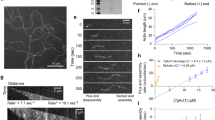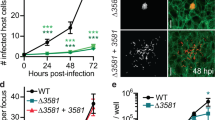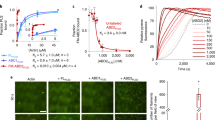Abstract
The actin cytoskeleton is a dynamic network that is composed of a variety of F-actin structures. To understand how these structures are produced, we tested the capacity of proteins to direct actin polymerization in a bead assay in vitro and in a mitochondrial-targeting assay in cells. We found that human zyxin and the related protein ActA of Listeria monocytogenes can generate new actin structures in a vasodilator-stimulated phosphoprotein-dependent (VASP) manner, but independently of the Arp2/3 complex. These results are consistent with the concept that there are multiple actin-polymerization machines in cells. With these simple tests it is possible to probe the specific function of proteins or identify novel molecules that act upon cellular actin polymerization.
This is a preview of subscription content, access via your institution
Access options
Subscribe to this journal
Receive 12 print issues and online access
$209.00 per year
only $17.42 per issue
Buy this article
- Purchase on Springer Link
- Instant access to full article PDF
Prices may be subject to local taxes which are calculated during checkout








Similar content being viewed by others
References
Machesky, L. M. et al. The mammalian Arp2/3 complex localizes to regions of lamellipodial protrusion and is composed of conserved subunits. Biochem. J. 328, 105–112 (1997).
Bailly, M. et al. Relationship between Arp2/3 complex and the barbed ends of actin filaments at the leading edge of carcinoma cells after epidermal growth factor stimulation. J. Cell Biol. 145, 331–345 (1999).
Beckerle, M. C. Identification of a new protein localized at sites of cell-substrate adhesion. J. Cell Biol. 103, 1679–1687 (1986).
Tilney, L. G. & Portnoy, D. A. Actin filaments and the growth, movement, and spread of the intracellular bacterial parasite, Listeria monocytogenes. J. Cell Biol. 109, 1597–1608 (1989).
Machesky, L. M. et al. Scar, a WASp-related protein, activates nucleation of actin filaments by the Arp2/3 complex. Proc. Natl Acad. Sci. USA 96, 3739–3744 (1999).
Rohatgi, R. et al. The interaction between N-Wasp and the Arp2/3 complex links Cdc42-dependent signals to actin assembly. Cell 97, 221–231 (1999).
Mullins, R. D., Heuser, J. A. & Pollard, T. D. The interaction of Arp2/3 complex with actin: Nucleation, high affinity pointed end capping, and formation of branching networks of filaments. Proc. Natl Acad. Sci. 95, 6181–6186 (1998).
Svitkina, T. M. & Borisy, G. C. Arp2/3 complex and actin depolymerizing factor/cofilin in dendritic organization and treadmilling of actin filament array in lamellipodia. J. Cell Biol. 145, 1009–1026 (1999).
Small, J. V., Herzog, M. & Anderson, K. Actin filament organization in the fish keratocyte lamellipodium. J. Cell Biol. 129, 1275–1286 (1995).
Domann, E. et al. A novel bacterial virulence gene in Listeria monocytogenes required for host cell microfilament interaction with homology to the proline-rich region of vinculin. EMBO J. 11, 1981–1990 (1992).
Kocks, C. et al. L. monocytogenes-induced actin assembly requires the actA gene product, a surface protein. Cell 68, 521–531 (1992).
Golsteyn, R. M., Beckerle, M. C., Koay, T. & Friederich, E. Structural and functional similarities between the human cytoskeletal protein zyxin and the ActA protein of Listeria monocytogenes. J. Cell Sci. 110, 1893–1906 (1997).
Crawford, A. W. & Beckerle, M. C. Purification and characterization of zyxin, an 82,000-Dalton component of adherens junctions. J. Biol. Chem. 266, 5847–5853 (1991).
Beckerle, M. C. Zyxin: zinc fingers at sites of cell adhesion. BioEssays 19, 949–957 (1997).
Macalma, T. et al. Molecular characterization of human zyxin. J. Biol. Chem. 271, 31470–31478 (1996).
Zumbrunn, J. & Trueb, B. A zyxin-related protein whose synthesis is reduced in virally transformed fibroblasts. Eur. J. Biochem. 241, 657–663 (1996).
Petit, M. M., Mols, R., Schoenmakers, E. F., Mandahl, N. & Van De Ven, W. J. LPP, the preferred fusion partner gene of HMGIC in lipomas, is a novel member of the LIM protein gene family. Genomic 36, 118–129 (1996).
Yi, J. & Beckerle, M. The human TRIP6 gene encodes a LIM domain protein and maps to chromosome 7q22, a region associated with tumorigenesis. Genomics 49, 314–316 (1998).
Niebuhr, K. et al. A novel proline-rich motif present in ActA of Listeria monocytogenes and cytoskeletal proteins is the ligand for the EVH1 domain, a protein module present in the Ena/VASP family. EMBO J. 16, 5433–5444 (1997).
Drees, B. et al. Characterization of the interaction between zyxin and Ena/VASP family of proteins. J. Biol. Chem. 275, 22503–22511 (2000).
Lasa, I., David, V., Gouin, E., Marchand, J. P. & Cossart, P. The amino-terminal part of ActA is critical for the actin-based motility of Listeria monocytogenes; the central proline-rich region acts as a stimulator. Mol. Microbiol. 18, 425–426 (1995).
Smith, G. A., Theriot, J. A. & Portnoy, D. A. The tandem repeat domain in the Listeria monocytogenes ActA protein controls the rate of actin-based motility, the percentage of moving bacteria, and the localization of vasodilator-stimulated phosphoprotein and profilin. J. Cell Biol. 135, 647–660 (1996).
Loisel, T. P., Boujemaa, R., Pantaloni, D. & Carlier, M. F. Reconstitution of actin-based motility of Listeria and Shigella using pure proteins. Nature 401, 613–616 (1999).
Castellano, F. et al. Inducible recruitment of Cdc42 or WASP to a cell-surface receptor triggers actin polymerization and filopodium formation. Curr. Biol. 9, 351–360 (1999).
May, R. C. et al. The Arp2/3 complex is essential for the actin-based motility of Listeria monocytogenes. Curr. Biol. 9, 759–762 (1999).
Reinhard, M. et al. An α-actinin binding site of zyxin is essential for subcellular zyxin localization and α-actinin recruitment. J. Biol. Chem. 274, 13410–13418 (1999).
Cameron, L. A., Footer, M. J., Van Oudenaarden, A. & Theriot, J. A. Motility of ActA protein-coated microspheres driven by actin polymerization. Proc. Natl Acad. Sci. USA 96, 4908–4913 (1999).
Noireaux, V. et al. Growing an actin gel on spherical surfaces. Biophys. J. 278, 1643–1654 (2000).
Welch, M. D., Iwamatsu, A. & Mitchison, T. J. Actin polymerization is induced by Arp2/3 protein complex at the surface of Listeria monocytogenes. Nature 385, 265–269 (1997).
Lasa, I. et al. Identification of two regions in the amino terminal domain of ActA involved in the actin comet tail formation by Listeria monocytogenes. EMBO J. 16, 1531–1540 (1997).
van Oudenaarden, A. & Theriot, J. A. Cooperative symmetry-breaking by actin polymerization in a model for cell motility. Nature Cell Biol. 1, 493–499 (1999).
Zhukarev, V., Ashton, F., Sanger, J. M., Sanger, J. W. & Shuman, H. Organization and structure of actin filament bundles in Listeria infected cells. Cell Motil. Cytoskeleton 30, 229–246 (1995).
Sechi, A., Wehland, J. & Small, J. V. The isolated comet tail pseudopodium of Listeria monocytogenes: a tail of two actin filament populations, long and axial and short and random. J. Cell Biol. 137, 155–167 (1997).
Blanchoin, L. et al. Direct observation of dendretic actin filament networks nucleated by Arp2/3 complex and WASP/Scar proteins. Nature 404, 1007–1111 (2000).
Beckerle, M. C. Spatial control of actin filament assembly: Lessons from Listeria. Cell 95, 741–748 (1998).
Drees, B., Andrews, K. M. & Beckerle, M. C. Molecular dissection of zyxin function reveals its involvement in cell motility. J. Cell Biol. 147, 1549–1560 (1999).
Laurent, V. et al. Role of proteins of the Ena-VASP family in actin-based motility of Listeria monocytogenes. J. Cell Biol. 144, 1245–1258 (1999).
Carlsson, L., Nyström, L.-E., Sundkvist, I., Markey, F. & Lindberg, U. Actin polymerizability is influenced by profilin, a low molecular weight protein in non-muscle cells. J. Mol. Biol. 115, 465–483 (1977).
Reinhard, M. et al. The proline-rich focal adhesion and microfilament protein VASP is a ligand for profilins. EMBO J. 14, 1583–1589 (1995).
Machesky, L. M., Atkinson, S. J., Ampe, C., Vandekerckhove, J. & Pollard, T. D. Purification of a cortical complex containing two unconventional actins from Acanthamoeba by affinity chromatography on profilin agarose. J. Cell Biol. 127, 107–115 (1994).
Higgs, H. N. & Pollard, T. D. Regulation of actin polymerization by Arp2/3 complex and WASp/Scar proteins. J. Biol. Chem. 274, 32531–32534 (1999).
Fradelizi, J., Friederich, E., Beckerle, M. C. & Golsteyn, R. M. Quantitative measurement of proteins by western blotting with Cy5 coupled secondary antibodies. Biotechniques 26, 484–494 (1999).
Laurent, V. & Carlier, M.-F. in Cell Biology: A laboratory manual (ed Celis, J.) 359–365 (Academic Press, Toronto, 1998).
Kreis, T. E., Geiger, B. & Schlessinger, J. Mobility of microinjected rhodamine actin within living chicken gizzard cells determined by fluorescence photobleaching recovery. Cell 29, 835–845 (1982).
Friederich, E. et al. Targeting of Listeria monocytogenes ActA protein to the plasma membrane as a tool to dissect both actin-based cell morphogenesis and ActA function. EMBO J. 14, 2731–2744 (1995).
Acknowledgements
We thank L. Cabanié for technical support and members of the Louvard laboratory and M. Beckerle for valuable discussions. We also thank P. Chavrier, P. Cossart, E. Gouin, L. Hoffman, C. Koehler and L. Machesky for generously providing reagents. This work was supported by a Curie Fellowship (to R.M.G. and J.P.), a MENRT fellowship (to J.F. and V.N.), and grants from the Association pour la Recherche sur le Cancer and the Centre National de la Recherche Scientifique (France).
Author information
Authors and Affiliations
Corresponding authors
Supplementary information
Supplementary figure
Figure S1 Effect of cytochalasin D on the ATPase activity of actin during polymerization. (PDF 26 kb)
Figure S2 Inhibition of actin polymerization on the surface of WA or ActA-Pro-beads by increasing concentrations of latrunculin.
Figure S3 Quantification of fluorescence associated with WA or ActA-Pro beads immunostained for VASP or Arp3 in the absence of latrunculin A.
Rights and permissions
About this article
Cite this article
Fradelizi, J., Noireaux, V., Plastino, J. et al. ActA and human zyxin harbour Arp2/3-independent actin-polymerization activity. Nat Cell Biol 3, 699–707 (2001). https://doi.org/10.1038/35087009
Received:
Revised:
Accepted:
Published:
Issue Date:
DOI: https://doi.org/10.1038/35087009
This article is cited by
-
Essential role of zyxin in platelet biogenesis and glycoprotein Ib-IX surface expression
Cell Death & Disease (2021)
-
Growth factor dependent changes in nanoscale architecture of focal adhesions
Scientific Reports (2021)
-
Dynamics and distribution of paxillin, vinculin, zyxin and VASP depend on focal adhesion location and orientation
Scientific Reports (2019)
-
A Rac/Cdc42 exchange factor complex promotes formation of lateral filopodia and blood vessel lumen morphogenesis
Nature Communications (2015)
-
Regulation of focal adhesion formation by a vinculin-Arp2/3 hybrid complex
Nature Communications (2014)



